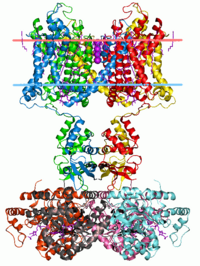
Photo from wikipedia
Pore space partitioning (PSP) is methodically suited for dramatically increasing the density of guest binding sites, leading to the partitioned acs (pacs) platform capable of record-high uptake for CO2 and… Click to show full abstract
Pore space partitioning (PSP) is methodically suited for dramatically increasing the density of guest binding sites, leading to the partitioned acs (pacs) platform capable of record-high uptake for CO2 and small hydrocarbons such as C2Hx. For gas separation, achieving high selectivity amid PSP-enabled high uptake offers an enticing prospect. Here we aim for high selectivity by introducing the bioisosteric (BIS) concept, a widely used drug design strategy, into the realm of pore-space-partitioned MOFs. New pacs materials have high C2H2/CO2 selectivity of up to 29, high C2H2 uptake of up to 144 cm3/g (298 K, 1 atm), and high separation potential of up to 5.3 mmol/g, leading to excellent experimental breakthrough performance. These metrics, coupled with exceptional tunability, high stability, and low regeneration energy, demonstrate the broad potential of the BIS-PSP strategy.
Journal Title: Journal of the American Chemical Society
Year Published: 2022
Link to full text (if available)
Share on Social Media: Sign Up to like & get
recommendations!